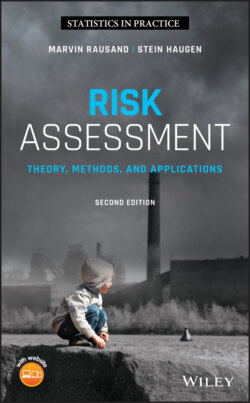Читать книгу Risk Assessment - Marvin Rausand - Страница 264
References
Оглавление1 Ale, B.J.M. (2005). Tolerable or acceptable: a comparison of risk regulation in the United Kingdom and in the Netherlands. Risk Analysis 25: 231–241.
2 Ashenfelter, O. (2005). Measuring value of a statistical life: Problems and prospects, Working paper 505. Princeton, NJ: Princeton University.
3 Aven, T. (2007). On the ethical justification for the use of risk acceptance criteria. Risk Analysis 27: 303–312.
4 Aven, T. and Vinnem, J.E. (2005). On the use of risk acceptance criteria in the offshore oil and gas industry. Reliability Engineering & System Safety 90: 15–24.
5 Bottelberghs, P.H. (2000). Risk analysis and safety policy developments in the Netherlands. Journal of Hazardous Materials 71: 59–84.
6 Cameron, R.F. and Willers, A. (2001). Use of risk assessment in the nuclear industry with specific reference to the Australian situation. Reliability Engineering & System Safety 74: 275–282.
7 CCPS (2009). Guidelines for Developing Quantitative Safety Risk Criteria. Hoboken, NJ: Wiley and Center for Chemical Process Safety, American Institute of Chemical Engineers.
8 CNCS (2009). Guidance on the use of deterministic and probabilistic criteria in decision‐making for class I nuclear facilities, Draft RD‐152. Ottawa, Canada: Canadian Nuclear Safety Commission.
9 Court of Appeal (1949). Edwards vs national coal board.
10 EN 50126 (1999). Railway Applications: The Specification and Demonstration of Reliability, Availability, Maintainability and Safety (RAMS). Brussels: European Norm.
11 EU (2000). Communication from the commission on the precautionary principle, Communication. Brussels: Commission of the European Communities.
12 EU (2001). Directive 2001/18/EC of the European Parliament and of the Council of 12th March 2001 on the deliberate release into the environment of genetically modified organisms.
13 EU (2016). Directive (EU) 2016/798 of the European Parliament and of the Council of 11 May 2106 on railway safety.
14 Fischhoff, B., Lichtenstein, S., and Keeney, R.L. (1981). Acceptable Risk. Cambridge: Cambridge University Press.
15 Garnett, K. and Parsons, D. (2017). Multi‐case review of the application of the precautionary principle in European Union law and case law. Risk Analysis 37 (3): 502–516.
16 HSE (1992). The Tolerability of Risk from Nuclear Power Stations. London: HMSO.
17 HSE (2001). Reducing Risks, Protecting People; HSE's Decision‐Making Process. Norwich: HMSO.
18 Johansen, I.L. (2010). Foundations and Fallacies of Risk Acceptance Criteria. ROSS report 201001. Trondheim, Norway: Norwegian University of Science and Technology.
19 Klinke, A. and Renn, O. (2002). A new approach to risk evaluation and management: risk‐based, precaution‐based, and discourse‐based strategies. Risk Analysis 22 (6), 1071–1094.
20 Nordland, O. (2001). When is risk acceptable? Presentations at 19th International System Safety Conference, Huntsville, AL.
21 NS 5814 (2008). Requirements for Risk Assessment, Norwegian edn. Oslo, Norway: Standard Norge.
22 NSW (2011). Risk Criteria for Land Use Safety Planning: Hazardous Industry Planning Advisory Paper No. 4. Technical report. Sydney, Australia: New South Wales, Department of Planning. ISBN: 978‐0‐73475‐872‐9.
23 Pandey, M.D. and Nathwani, J.S. (2004). Life quality index for the estimation of societal willingness‐to‐pay for safety. Structural Safety 26: 181–199.
24 Royal Society (1992). Risk: Analysis, Perception and Management. London: Report of a Royal Society study group, Royal Society.
25 Schäbe, H. (2001). Different approaches for determination of tolerable hazard rates. In: Towards a Safer World (ESREL'01) (ed. E. Zio, M. Demichela, and N. Piccinini). Turin, Italy: Politechico di Torino.
26 UN (1992). Report of the United Nations Conference on Environment and Development, Rio Declaration on Environment and Development. Tech. Rep. A/CONF.151/26/Rev. 1 (Vol. 1). New York: United Nations.
